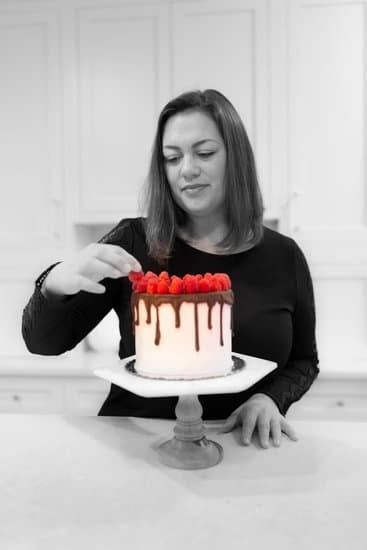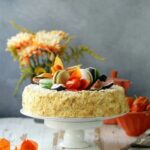Fondant has become a staple in the world of cake decorating, allowing bakers to create stunning and intricate designs that simply cannot be achieved with traditional buttercream icing. The smooth and flawless appearance of fondant makes it the ideal canvas for attaching fondant decorations, which can take a cake from ordinary to extraordinary.
Whether you’re a professional baker or just starting out, understanding how to properly attach fondant decorations to a fondant cake is essential for achieving those showstopping designs.
Fondant itself is a pliable and dough-like icing that can be rolled out and draped over cakes to create a smooth, polished finish. Its popularity stems from its versatility and ability to hold its shape, making it perfect for molding into various decorations like flowers, figures, or even intricate patterns. Fondant also provides a blank canvas for edible paints or powders, allowing bakers to experiment with different colors and textures.
To ensure success when attaching fondant decorations to your cake, it’s crucial to start with properly prepared fondant. Achieving the right texture and consistency is key in ensuring that your decorations adhere securely without sliding or sagging. Additionally, selecting the right type of fondant decorations that match your desired cake design is essential in creating a cohesive and visually appealing finished product.
In the following sections of this article, we will explore various tips and techniques for successfully attaching fondant decorations to your fondant cake. We will discuss preparations such as icing and smoothing the cake surface, as well as highlighting the necessary tools such as edible glue or royal icing that are essential in securing your decorations.
Furthermore, we will provide step-by-step instructions on how to attach both large figurines or delicate flowers without damaging them. So let’s dive in and learn the art of attaching fondant decorations to elevate our cake decorating skills.
Understanding the importance of properly prepared fondant
Fondant is a popular choice for cake decorating due to its smooth, satin-like finish and limitless design possibilities. However, achieving the perfect texture and consistency of fondant is crucial for successful cake decoration. Improperly prepared fondant can lead to difficulties in attaching decorations and result in a less-than-desirable final product. This section will provide valuable tips to ensure your fondant is properly prepared.
- Sifting and kneading: Before using fondant, it is essential to sift it thoroughly to remove any lumps or impurities. A fine-mesh sieve or sifter can help achieve a smooth consistency. Once sifted, knead the fondant on a clean surface until it becomes soft and pliable. This process helps to distribute any remaining lumps evenly throughout the fondant.
- Using powdered sugar: Dust your work surface with powdered sugar before rolling out the fondant. This helps prevent sticking and provides a smooth working area for shaping and cutting out decorations.
- Achieving the right consistency: Fondant should have a pliable consistency that allows for easy rolling and shaping while still holding its shape when attached to the cake. If your fondant feels too dry or stiff, you can add small amounts of water or glycerin gradually while kneading until you reach the desired texture.
- Storing properly: It’s important to store unused fondant properly to avoid drying out or becoming too soft. Wrap it tightly in plastic wrap and place it in an airtight container or resealable bag. Store at room temperature in a cool, dry place away from direct sunlight.
By following these tips for proper preparation of fondant, you can ensure that your decorations will adhere smoothly to your cake without any issues. Remember that practice makes perfect, so don’t be discouraged if you encounter difficulties initially – with time and experience, you’ll become more proficient at working with fondant and achieving the perfect texture and consistency.
Choosing the right fondant decorations
Choosing the right fondant decorations is crucial in making your cake design look cohesive and visually appealing. There are various types of fondant decorations available, each with its unique characteristics and uses. By understanding these options, you can select the perfect decorations that will complement your desired cake design.
One popular type of fondant decoration is fondant cutouts. These are pre-made shapes that can be used to add intricate details to your cake. Fondant cutouts come in a wide range of designs, such as flowers, leaves, animals, or even personalized messages. They can be easily attached to the fondant surface using edible glue or water.
Another option is fondant molds. These are specially designed molds that allow you to create three-dimensional shapes and patterns out of fondant. This is a great choice if you want to add depth and dimension to your decorations. Fondant molds are available in various designs, such as lace patterns, bows, or even elaborate figurines.
If you prefer a more artistic touch, you can explore the world of hand-modeled fondant decorations. This technique involves shaping small amounts of fondant into intricate designs by hand. It allows for more creativity and customization as you can mold the fondant into any shape or form you desire.
To help you select the right type of fondant decoration for your cake design, consider the overall theme and style you want to achieve. For example, if you’re going for an elegant and sophisticated look, delicate hand-molded flowers or lace patterns would be a great choice. On the other hand, if you’re creating a whimsical or playful design, using pre-made cutouts or bold-colored molded figurines might be more suitable.
Preparing the cake surface for fondant attachments
Properly icing and smoothing the cake surface is a crucial step in creating a solid base for fondant decorations. This ensures that the fondant adheres smoothly to the cake and prevents any bumps or imperfections from showing through. Here are some tips for preparing the cake surface before attaching fondant decorations.
First, it’s important to level the cake layers so that they are even and will stack properly. Use a serrated knife or a cake leveler to trim off any domed tops, making sure each layer is flat and even. This will help create a stable foundation for your fondant decorations.
Next, apply a crumb coat of frosting to the entire cake. This thin layer of frosting seals in any loose crumbs and provides a smooth surface for the fondant to adhere to. Use an offset spatula or a bench scraper to spread the frosting evenly over the sides and top of the cake.
Once you have applied the crumb coat, refrigerate the cake for about 10-15 minutes to allow the frosting to firm up. This will make it easier to apply another layer of icing, known as the final coat.
For the final coat of icing, use an offset spatula or a straightedge smoother to apply a thicker layer of frosting. Start by spreading icing on top of the cake, then move on to the sides, working in smooth, even strokes. The goal is to create a perfectly smooth finish on all surfaces of the cake.
After applying the final coat, take extra care to ensure that there are no visible gaps or uneven areas in the frosting. Smooth out any imperfections with your spatula or smoother, using gentle pressure as needed.
By properly icing and smoothing your cake surface, you will create a solid base that will not only support your fondant decorations but also provide a professional-looking finish. Taking time to prepare this foundation will result in stunning cakes that are sure to impress.
Necessary tools and materials for attaching fondant decorations
When it comes to attaching fondant decorations to a cake, having the right tools and materials is essential. These tools not only help make the attachment process easier but also ensure that your fondant decorations stay securely in place. Here are some necessary tools and materials that you will need:
- Edible Glue: Edible glue is a must-have tool for attaching fondant decorations. It is specially formulated to work with edible materials, such as fondant or gum paste. Edible glue comes in different forms like liquid or gel, and it helps to create a strong bond between the decorations and the cake surface.
- Piping Gel: Piping gel is another useful tool for attaching fondant decorations. It has a thick consistency, making it ideal for creating texture on cakes or sealing the edges of fondant pieces. Piping gel can also be used as an adhesive to attach larger or heavier fondant decorations.
- Royal Icing: Royal icing is a versatile icing made from egg whites and powdered sugar. It dries hard, which makes it perfect for securing fondant decorations to the cake surface. Royal icing can be used for detailed work, such as piping intricate designs or attaching delicate fondant pieces.
- Fondant Smoother: A fondant smoother is not only used for creating a smooth surface on the cake but also plays a role in attaching fondant decorations. You can use the flat edge of a smoother to gently press the decorations onto the cake surface, ensuring they adhere properly.
- Small Paintbrushes: Having small paintbrushes dedicated solely for food use is important when working with fondant decorations. These brushes can be used to apply edible glue or piping gel precisely onto the desired areas of both the decoration and cake.
Remember to always have these essential tools and materials on hand before starting your cake decorating project involving attaching fondant decorations. They will make the process much smoother and help ensure that your decorations stay in place.
Attaching large fondant decorations
Attaching large fondant decorations requires careful positioning and secure attachment to ensure they do not topple or fall off the cake. Whether you are working with figurines or toppers, following step-by-step instructions and implementing the appropriate tips will help you achieve a successful outcome.
To begin, make sure that your fondant decoration is properly sized and proportioned for your cake. This will ensure that it fits well on the surface without overwhelming the design. If necessary, use a ruler or template to measure and cut the fondant to the desired shape and size.
Once your decoration is ready, prepare a small amount of edible glue, piping gel, or royal icing for adhesion. These substances act as an adhesive agent that will hold the fondant decoration securely in place. Apply a thin layer of glue using a small brush or toothpick to both the cake surface where the decoration will be placed and the bottom of the fondant piece itself.
Carefully position and gently press down on the decorated fondant piece onto the desired spot on the cake’s surface. Make sure it adheres firmly but avoid applying too much pressure or pushing it too far into the icing, as this may cause damage. Allow some time for the attachment to dry and set in place before moving on to other decorations or handling.
Throughout this process, it is essential to handle large fondant decorations delicately to prevent any breakages or misalignment. Take caution when transporting cakes with large decorations attached as they can easily get damaged during movement.
| Key Points |
|---|
| – Size and proportion are important considerations. |
| – Use an adhesive like edible glue, piping gel, or royal icing. |
| – Gently press the decoration onto the cake surface. |
| – Handle large decorations delicately to avoid breakages. |
By following these step-by-step instructions and incorporating these tips, you can confidently attach large fondant decorations to your cakes without worry. Taking the time to properly position and secure your decorations will result in a visually stunning and structurally sound finished product.
Attaching delicate fondant decorations
When it comes to attaching delicate fondant decorations to a cake, such as flowers or intricate designs, it’s important to handle them with care to avoid any damage. These delicate decorations can add a touch of elegance and beauty to your fondant cake, but they require special techniques for secure attachment. In this section, we will explore some methods for handling and attaching delicate fondant decorations without compromising their integrity.
Handling delicate fondant decorations
Before attempting to attach delicate fondant decorations, it’s crucial to handle them properly in order to avoid any breakage or distortion. Here are some tips for handling these fragile elements:
- Use clean, dry hands or food-safe gloves: Moisture and dirt can easily damage the delicate surfaces of fondant decorations. Ensure that your hands are clean and completely dry before touching them. Alternatively, wearing food-safe gloves can help prevent any unwanted marks or smudges.
- Work in a cool environment: Fondant is sensitive to heat and humidity, which can cause it to become sticky and soft. To maintain the shape and texture of delicate fondant decorations, work in a cool environment with controlled temperature and low humidity levels.
- Roll out the fondant thinly: Delicate fondant decorations are more prone to breakage if they are too thick. Roll out the fondant thinly using a rolling pin dusted with confectioners’ sugar or cornstarch. This will give the decorations a finer and more delicate appearance.
Attaching delicate fondant decorations
Once you have handled the delicate fondant decorations with care, it’s time to attach them securely to your cake without causing any damage. Here are some techniques for attaching these fragile elements:
- Edible glue: Edible glue is an essential tool when attaching delicate fondant decorations. Apply a small amount of edible glue onto the backside of the decoration using a food-safe brush or toothpick. Gently press the decoration onto the desired spot on the cake, holding it in place for a few seconds to ensure proper adherence.
- Piping gel: Piping gel can also be used to attach delicate fondant decorations. Its slightly tacky texture provides a strong and reliable bond. Apply a small amount of piping gel onto the backside of the decoration using a piping bag or a small spatula. Carefully place the decoration onto the cake, gently pressing it into position.
- Royal icing: If you prefer a sturdier attachment, royal icing can be used for delicate fondant decorations. Prepare a batch of royal icing with medium consistency and transfer it into a piping bag fitted with a small round tip. Pipe small dots or lines of royal icing onto the backside of the decoration, then press it firmly onto the cake.
By following these techniques for handling and attaching delicate fondant decorations, you can add intricate beauty to your cake without worrying about damage or displacement. Remember to take your time and work with precision, ensuring that your fondant cake maintains its gorgeous appearance throughout its presentation.
Adding depth and dimension
Adding depth and dimension to fondant decorations can take your cake design to the next level. By incorporating these techniques, you can create visually stunning decorations that make a statement. There are several methods you can use to achieve this, including layering, shading, and using 3D molds.
Layering
One way to add depth to fondant decorations is through layering. This involves creating multiple layers of fondant and stacking them on top of each other. For example, if you are creating a flower decoration, you can roll out different colors of fondant and cut them into varying sizes of petals.
Layer the petals on top of each other, making sure to secure them with a small amount of edible glue or water between each layer. This will give the decoration a layered effect and add depth.
Shading
Shading is another technique that can be used to create depth in fondant decorations. It involves using different shades of the same color or different colors altogether to highlight certain areas of the decoration. For example, if you are creating a fondant butterfly, you can use a lighter shade for the wings’ inner sections and a darker shade for the outer edges. By blending these shades together, it creates depth and makes the wings appear more realistic.
Using 3D Molds
Another method for adding depth and dimension is by using 3D molds. These molds come in various shapes and designs and can be used to create intricate details on your fondant decorations. Simply press the fondant into the mold firmly, making sure it fills all the crevices. After removing it from the mold, you will have a decoration with raised details that instantly adds depth and dimension to your cake design.
By utilizing these techniques – layering, shading, and using 3D molds – you can transform your plain fondant decorations into stunning pieces of art. Experiment with different combinations and designs to create unique effects that fit your desired cake design. Remember to practice and be patient as it may take some time to perfect these techniques, but the end result will certainly be worth it.
Troubleshooting common challenges
Sagging Fondant Decorations
One common challenge when attaching fondant decorations to a cake is the risk of sagging. Sagging can occur due to the weight of the fondant or improper support beneath the decoration. To prevent this issue, it is essential to ensure that your cake is well-structured and sturdy before attaching any fondant decorations. This can be achieved by using dowels or straws inserted into the cake layers for added support.
If you notice that your fondant decorations are starting to sag, there are a few quick solutions you can try. Firstly, gently lift the decoration and insert a small piece of fondant or gum paste behind it to support its weight.
You can also place some icing sugar or cornstarch on top of the cake in the area where the decoration is sagging to create friction and help hold it in place. Additionally, chilling your cake for a short period of time in the refrigerator can help firm up sagging fondant decorations.
Sliding Fondant Decorations
Another common issue when attaching fondant decorations is sliding. Sliding occurs when the attachments do not properly adhere to the cake surface or when they are not placed securely enough. To prevent sliding, make sure to properly prepare your cake surface by applying a thin layer of buttercream icing or piping gel, which acts as an adhesive for your fondant decorations.
If you find that your fondant decorations are still sliding after attachment, there are several troubleshooting methods you can try. Firstly, gently press down on the decoration with clean hands or use a flat tool like a spatula to secure it in place.
Alternatively, you can use edible glue or royal icing as additional adhesives to strengthen the attachment between the decoration and cake surface. It may also be helpful to hold down any sliding elements with toothpicks until they firmly set in place.
Cracking Fondant Decorations
Cracking is another challenge that may arise when attaching fondant decorations. Cracks can occur due to drying out or excessive handling of the fondant. To prevent cracking, always keep your fondant decorations covered with plastic wrap or in an airtight container to retain moisture. Additionally, avoid rolling the fondant too thin as this can make it prone to cracking.
If you encounter cracked fondant decorations, there are a few strategies you can employ for repair. Firstly, you can use a small amount of water and a paintbrush to lightly moisten the cracked areas and gently press them together to seal the cracks.
Alternatively, you can utilize edible glue or royal icing to act as adhesives between the cracked pieces and hold them together. Remember that when repairing cracked fondant decorations, it is important to do so with care and patience to avoid further damage.
By understanding and addressing these common challenges, you will be better equipped to troubleshoot any issues that may arise when attaching fondant decorations. With practice and patience, you will be able to confidently create stunning decorative designs on your fondant cakes without encountering sagging, sliding, or cracking problems.
Finishing touches and presentation
Adding the finishing touches to your fondant cake is what takes it from ordinary to extraordinary. These final details can really enhance the overall look and make your cake stand out. In this section, we will explore some tips for adding those finishing touches and presenting your fondant cake in a way that wows your guests.
One way to elevate the appearance of your fondant cake is by dusting it with edible powders. Edible powders, such as luster dust or petal dust, can add a touch of shimmer, color, or texture to your decorations.
To apply edible powders, use a soft brush or a dusting pouch and gently brush or dust the desired areas of your cake. You can use different colors and shades to create depth and dimension, or even mix them together to achieve a custom look.
Another option for adding depth and enhancing details is using edible paints. Edible paints come in various colors and are specifically formulated for food use. They can be applied directly onto fondant using a clean paintbrush or used with stencils to create intricate designs. Edible paints allow you to add fine details, vibrant colors, or even realistic textures to your fondant decorations.
In addition to edible powders and paints, there are other creative ways to finish off your fondant cake presentation. You can consider adding edible glitter for a touch of sparkle, piping royal icing borders for a polished look, or using decorative ribbons around the base of the cake for an elegant finish. Experiment with different techniques and materials until you find what works best for your desired design aesthetic.
Remember, presentation is key when it comes to showcasing your beautifully decorated fondant cake. Consider using a sturdy cake stand or pedestal that complements the design of your cake. You can also create an appealing backdrop by placing fresh flowers or other props around the cake display area.
By paying attention to these finishing touches and presenting your fondant cake with care, you’ll create a stunning centerpiece that not only looks amazing but also tastes delicious. Don’t be afraid to get creative and let your imagination run wild as you add those final details to make your fondant cake truly unforgettable.
Conclusion
In conclusion, attaching fondant decorations to a fondant cake is a popular and creative way to elevate the overall design and presentation of your baked creation. Through this article, we have explored various aspects of working with fondant decorations and provided essential tips and techniques to help you achieve successful attachments.
Firstly, understanding the importance of properly prepared fondant is crucial. Achieving the perfect texture and consistency will ensure that your decorations adhere securely to the cake surface without sagging or cracking. Properly icing and smoothing the cake also plays a significant role in creating a solid base for attaching fondant decorations.
Choosing the right fondant decorations can greatly enhance your cake design. Whether it’s large figurines or delicate flowers, selecting decorations that match your desired aesthetic is key. Additionally, we’ve discussed necessary tools such as edible glue, piping gel, or royal icing that assist in securely positioning and attaching these decorations.
By following step-by-step instructions and handling more delicate fondant decorations with care, you can confidently attach them without damaging their intricate designs. Adding depth and dimension through layering, shading, or using 3D molds further enhances the visual appeal of your cake.
To troubleshoot common challenges like sagging or sliding fondant decorations, we have provided practical solutions. Lastly, we’ve given suggestions for finishing touches like dusting with edible powders or using edible paints to add that final touch of elegance to your fondant cake.
In summary, by following these tips and techniques outlined in this article, you can confidently attach fondant decorations to your own cakes. Let your creativity flourish as you experiment with different designs and styles. With practice and patience, you’ll be able to create stunning cakes that impress both visually and taste-wise. So go ahead, unleash your inner artist on those sweet canvases.
Frequently Asked Questions
Does fondant icing stick to fondant icing?
Fondant icing does stick to fondant icing, but it requires some preparation to ensure a strong bond. Before applying a piece of fondant onto another, it is important to lightly brush the surface with water or apply a thin layer of edible glue.
This helps create a tacky surface that promotes adhesion between the two layers of fondant. By properly preparing the surface and using these techniques, fondant icing can stick securely without sliding or peeling off.
What can I use instead of edible glue?
If you don’t have any edible glue on hand, there are several alternatives you can use to adhere decorations or parts of fondant together. One option is using simple syrup, which is made by dissolving equal parts sugar and water over low heat until fully combined. Once cooled, you can brush it onto the surfaces that need to be bonded and press them together firmly.
Another alternative is using melted chocolate or candy melts as a glue substitute for heavier decorations or objects like cake pops. Simply melt the chocolate or candy melts in a microwave or double boiler, let it cool slightly, brush it on the desired areas, and press them together.
How far in advance can you decorate a cake with fondant?
The recommended time frame for decorating a cake with fondant varies depending on factors such as the type of cake, climate conditions, and specific design elements involved. In general, it is best to decorate a cake with fondant no more than 1-2 days in advance of when it will be served. This ensures that the fresh taste and texture are preserved while minimizing any potential issues such as sagging or drying out of the fondant.
It’s important to store the decorated cake in a cool and dry environment away from direct sunlight or humidity to maintain its appearance and structure. However, smaller individual fondant decorations can be made even earlier if stored properly in an airtight container at room temperature until ready to use.

Welcome to our cake decorating blog! My name is Destiny Flores, and I am the proud owner of a cake decorating business named Cake Karma. Our mission is to provide delicious, beautiful cakes for all occasions. We specialize in creating custom cakes that are tailored specifically to each customer’s individual needs and tastes.





